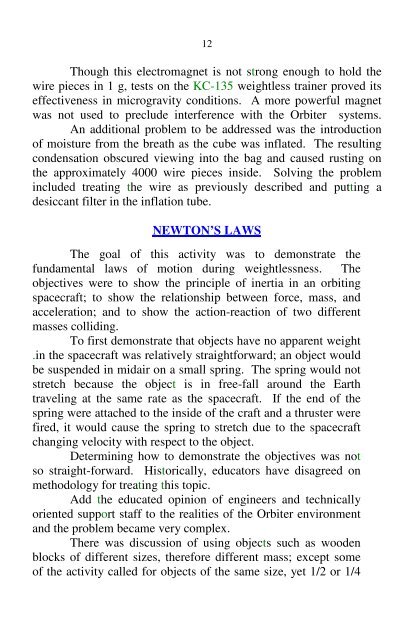CHALLENGER'S LOST LESSONS - ER - NASA
CHALLENGER'S LOST LESSONS - ER - NASA
CHALLENGER'S LOST LESSONS - ER - NASA
Create successful ePaper yourself
Turn your PDF publications into a flip-book with our unique Google optimized e-Paper software.
12Though this electromagnet is not strong enough to hold thewire pieces in 1 g, tests on the KC-135 weightless trainer proved itseffectiveness in microgravity conditions. A more powerful magnetwas not used to preclude interference with the Orbiter systems.An additional problem to be addressed was the introductionof moisture from the breath as the cube was inflated. The resultingcondensation obscured viewing into the bag and caused rusting onthe approximately 4000 wire pieces inside. Solving the problemincluded treating the wire as previously described and putting adesiccant filter in the inflation tube.NEWTON’S LAWSThe goal of this activity was to demonstrate thefundamental laws of motion during weightlessness. Theobjectives were to show the principle of inertia in an orbitingspacecraft; to show the relationship between force, mass, andacceleration; and to show the action-reaction of two differentmasses colliding.To first demonstrate that objects have no apparent weight.in the spacecraft was relatively straightforward; an object wouldbe suspended in midair on a small spring. The spring would notstretch because the object is in free-fall around the Earthtraveling at the same rate as the spacecraft. If the end of thespring were attached to the inside of the craft and a thruster werefired, it would cause the spring to stretch due to the spacecraftchanging velocity with respect to the object.Determining how to demonstrate the objectives was notso straight-forward. Historically, educators have disagreed onmethodology for treating this topic.Add the educated opinion of engineers and technicallyoriented support staff to the realities of the Orbiter environmentand the problem became very complex.There was discussion of using objects such as woodenblocks of different sizes, therefore different mass; except someof the activity called for objects of the same size, yet 1/2 or 1/4
















